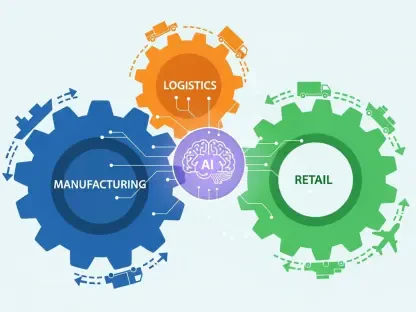In the heart of Asia-Pacific’s bustling digital economy, enterprises are facing a silent crisis: the skyrocketing costs of running artificial intelligence systems, a challenge that threatens their competitive edge. Imagine a retail giant in Southeast Asia losing millions annually due to sluggish AI responses that frustrate customers during peak shopping seasons—a scenario that is not hypothetical but a stark reality for many firms across the region as they grapple with the financial burden of AI inference, the process of using trained models for real-time decisions. With operational expenses spiraling out of control, a revolutionary shift is underway, moving AI workloads from centralized cloud systems to edge computing environments. This transition promises not just cost savings but a lifeline for businesses striving to stay competitive in a hyper-connected market.
The significance of this shift cannot be overstated. As APAC companies pour billions into AI to drive innovation in industries like retail, finance, and e-commerce, the hidden costs of inference are emerging as a major roadblock. Unlike model training, which is a one-time heavy lift, inference demands continuous resources, often outpacing budgets and infrastructure capabilities. Moving to the edge—processing data closer to users and devices—offers a way to slash latency, reduce expenses, and meet stringent regulatory demands. This story unfolds against the backdrop of a region defined by diversity in language, culture, and digital maturity, where adapting AI infrastructure is not just a technical challenge but a strategic imperative.
Why Are AI Costs Skyrocketing in APAC, and What’s the Fix?
Across APAC, enterprises are wrestling with an unexpected hurdle: the ballooning expense of keeping AI systems operational. Reports indicate that inference costs, which account for the bulk of AI spending in production environments, have surged by over 60% in key markets like India and Singapore in recent years. This financial strain stems from the sheer volume of real-time decisions AI must make, whether it’s powering chatbots or personalizing user experiences, often overwhelming traditional setups.
The primary culprit behind this cost explosion is the reliance on centralized cloud systems, which rack up hefty data transfer fees and struggle to deliver speed in geographically dispersed regions. For businesses operating across multiple countries, these inefficiencies translate into lost opportunities and frustrated customers. A fix is urgently needed to ensure AI remains a driver of growth rather than a drain on resources.
Enter edge computing—a solution gaining traction as a way to decentralize AI processing. By handling inference closer to where data is generated, companies can bypass many of the cost and performance pitfalls of the cloud. This approach is not just a technical tweak but a fundamental rethinking of how AI can be sustainably deployed in a region as vast and varied as APAC.
The Inference Challenge: Why Centralized Cloud Falls Short
Delving deeper into the issue, the limitations of centralized cloud infrastructure become glaringly apparent when it comes to AI inference. Unlike training, which can be scheduled and batched, inference requires constant, low-latency processing to deliver results in real time. Centralized systems, often located far from end users, introduce delays that can cripple applications where every millisecond counts, such as instant payment validations in finance.
Beyond latency, the financial burden of data transfer—often called egress fees—adds insult to injury. Moving massive datasets to and from distant cloud servers eats into budgets, especially for firms in remote areas of APAC where connectivity costs are already high. Additionally, regulatory constraints around data sovereignty in countries like Indonesia and Vietnam complicate matters, as data must often stay within national borders, clashing with centralized models.
The real-world fallout is tangible. Retailers lose sales when recommendation engines lag during high-traffic periods, while financial institutions face compliance risks and fraud losses due to delayed transaction monitoring. These challenges underscore why clinging to a cloud-only approach is no longer viable, pushing firms to explore alternatives that can keep pace with the demands of modern AI workloads.
Edge Computing as the Game-Changer for AI in APAC
Edge computing emerges as a transformative force in tackling these inference woes. By processing data at or near the point of origin—think local servers or even devices themselves—edge setups drastically cut down on latency, delivering near-instantaneous results. This speed is a boon for industries like e-commerce, where faster product suggestions can boost conversion rates by as much as 30%, according to recent studies.
Cost savings are another compelling advantage. Akamai’s analysis highlights that markets such as India and Vietnam have seen operational expenses for AI tasks like image generation drop by nearly 40% after shifting to edge infrastructure. These reductions come from minimized data transfer and more efficient use of hardware resources, making edge a financially savvy choice for budget-conscious firms.
Equally important is compliance with APAC’s patchwork of data laws. Edge computing allows data to be processed locally, aligning with strict regulations in various countries while still supporting global operations. For financial sectors, this means real-time fraud detection without risking regulatory penalties, positioning edge as not just a fix but a strategic enabler across diverse markets.
Expert Voices and Strategic Partnerships Fueling the Edge Revolution
Industry leaders are sounding the alarm on the need for this shift, with authoritative voices lending weight to the edge movement. Jay Jenkins, CTO of Cloud Computing at Akamai, emphasizes the creation of an “AI delivery network” through distributed infrastructure. “The edge isn’t just about proximity; it’s about building a scalable ecosystem where AI can thrive without breaking the bank,” Jenkins notes, pointing to the necessity of rethinking deployment models.
Strategic alliances are accelerating this transformation, notably the collaboration between Akamai and NVIDIA. By integrating advanced Blackwell GPUs into edge locations, this partnership enhances processing power and scalability, enabling firms to handle complex AI tasks with ease. Such collaborations are setting a new standard for how technology providers can support enterprise needs in real time.
The impact is already visible in the field. A major retailer in Southeast Asia, for instance, reported a 50% reduction in response times for customer queries after adopting edge-based AI solutions. This kind of success story illustrates the tangible benefits of leveraging expert insights and cutting-edge partnerships, proving that the edge revolution is not a distant dream but a present reality for forward-thinking companies.
Navigating the Edge: Practical Strategies for APAC Firms
For enterprises ready to make the leap, transitioning AI workloads to the edge requires a clear roadmap. The first step is identifying latency-sensitive applications—such as real-time analytics or customer-facing tools—that stand to gain the most from localized processing. Prioritizing these use cases ensures immediate impact on performance and user satisfaction.
Collaboration with cloud and hardware providers is crucial for scalability. Partnering with established players can provide access to tailored edge solutions, while investing in orchestration tools helps manage the complexities of distributed AI lifecycles. These tools enable seamless updates and monitoring across fragmented environments, ensuring consistency without sacrificing agility.
Security cannot be an afterthought in this distributed landscape. Implementing zero-trust protocols and data-aware routing is essential to protect against threats in edge setups. Additionally, balancing edge and cloud in a hybrid model allows firms to adapt to APAC’s dynamic conditions, mitigating risks while capitalizing on the best of both worlds. This strategic approach equips businesses to navigate the edge with confidence.
As the journey of APAC firms unfolds, the shift to edge computing stands as a pivotal moment in their battle against rising AI inference costs. Reflecting on this transformation, it becomes clear that the path forward hinges on sustained innovation and adaptability. Enterprises must prioritize building resilient hybrid infrastructures, blending edge and cloud capabilities to meet diverse market needs. Strengthening security frameworks remains a critical focus to safeguard distributed systems from emerging threats. Looking ahead, fostering deeper collaborations with technology providers promises to unlock even greater efficiencies, ensuring that AI can drive value without draining resources. This evolution marks not just a solution to a pressing challenge but a blueprint for sustainable growth in a region poised for digital dominance.









